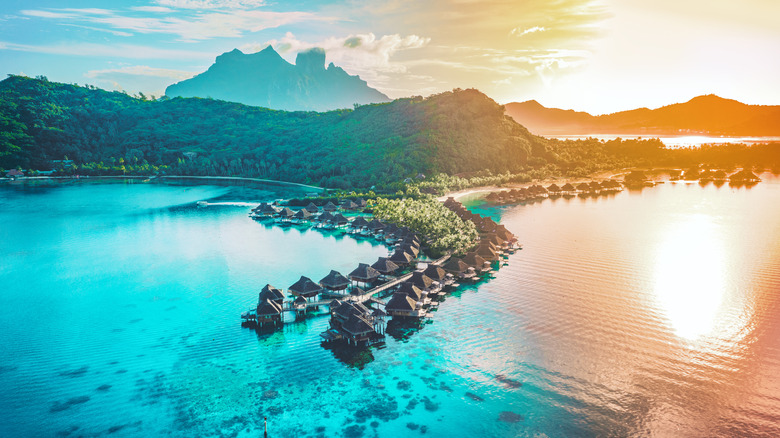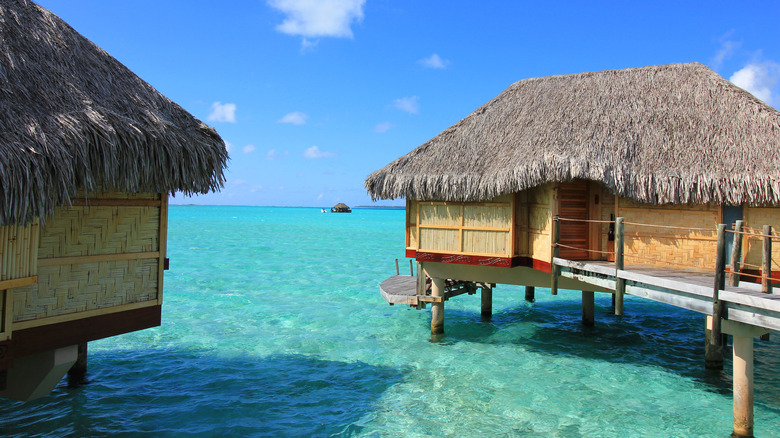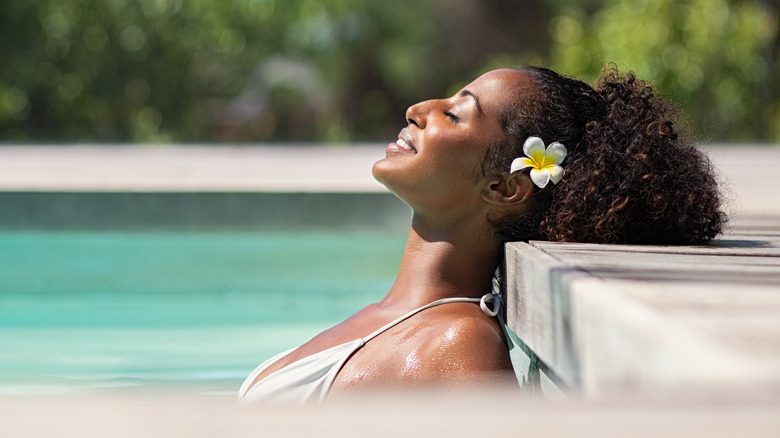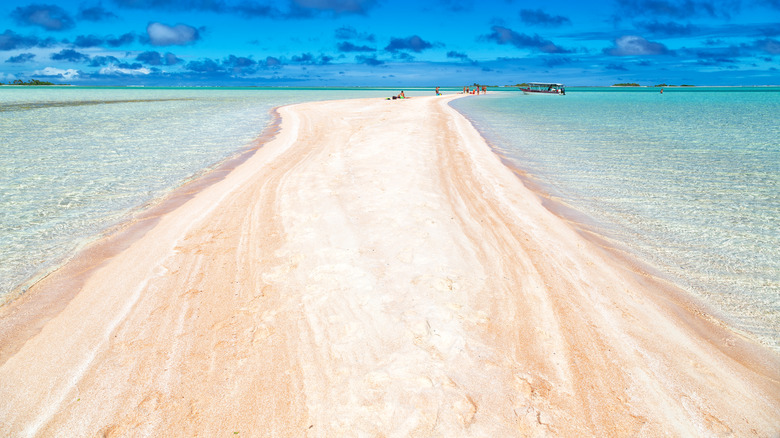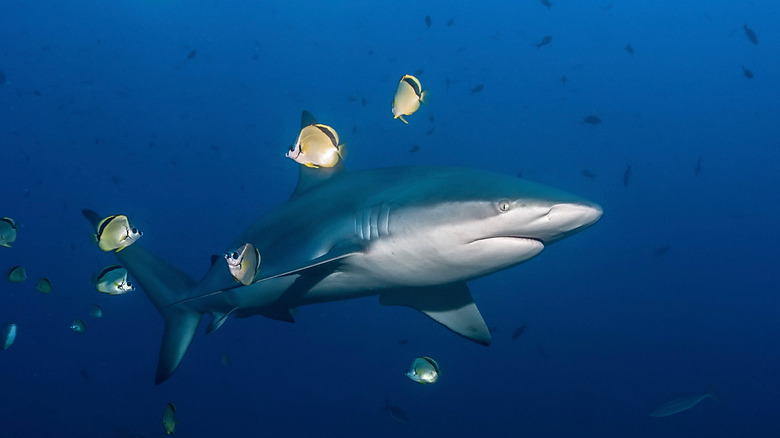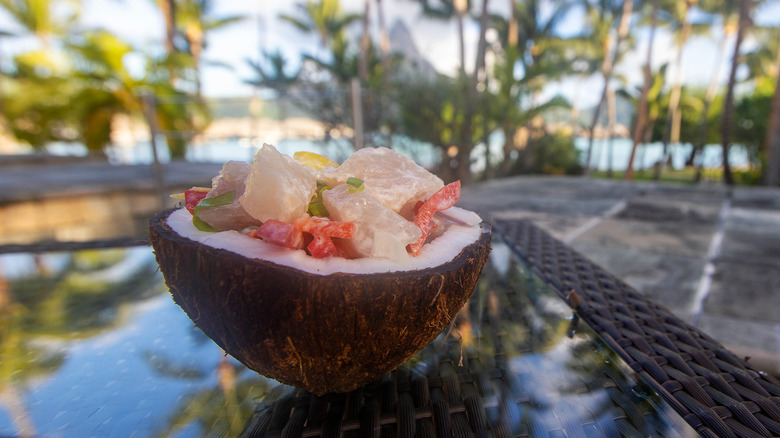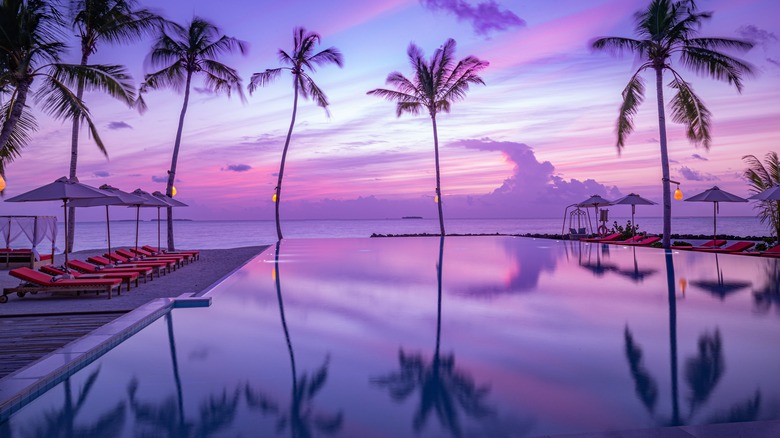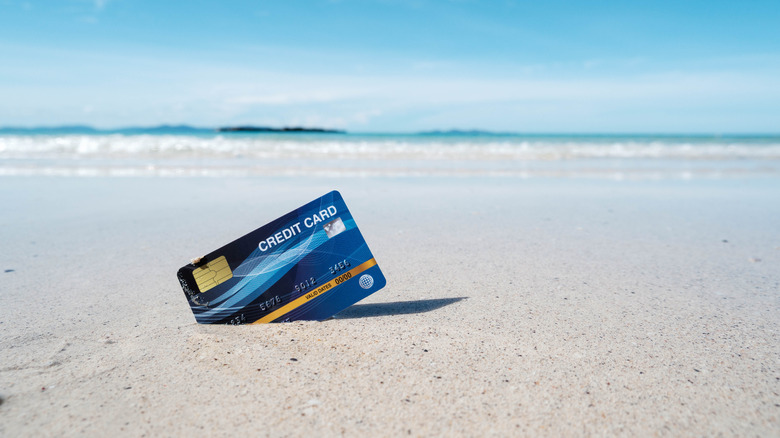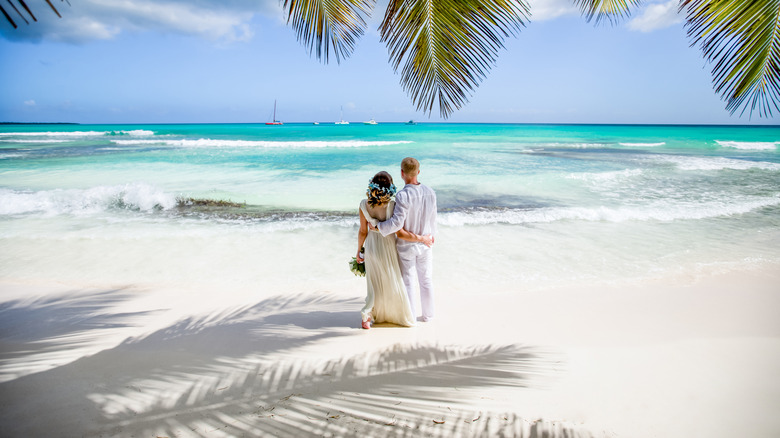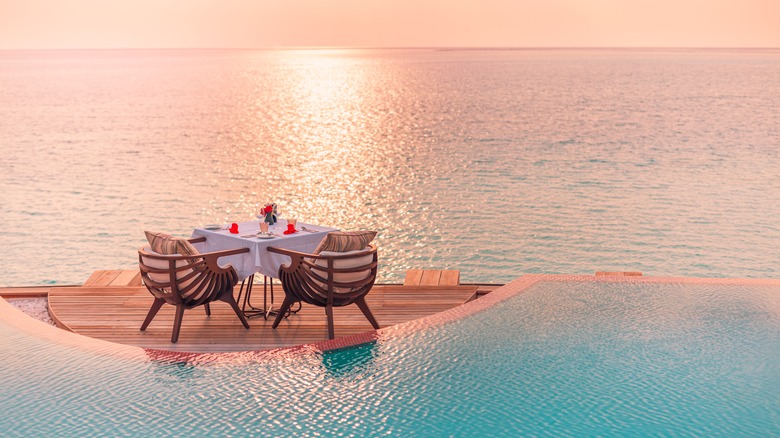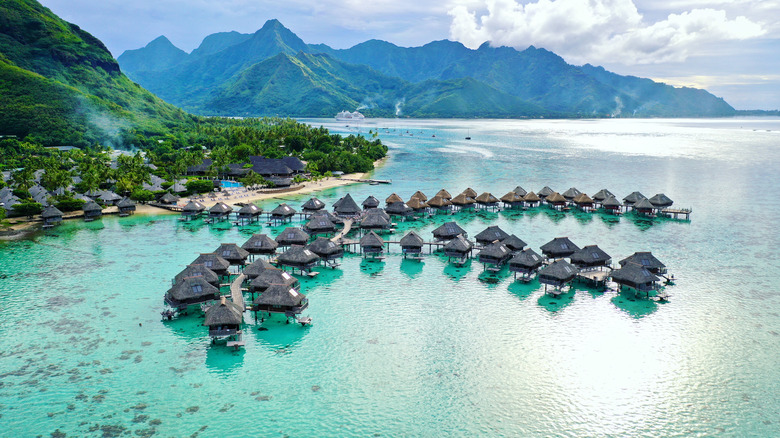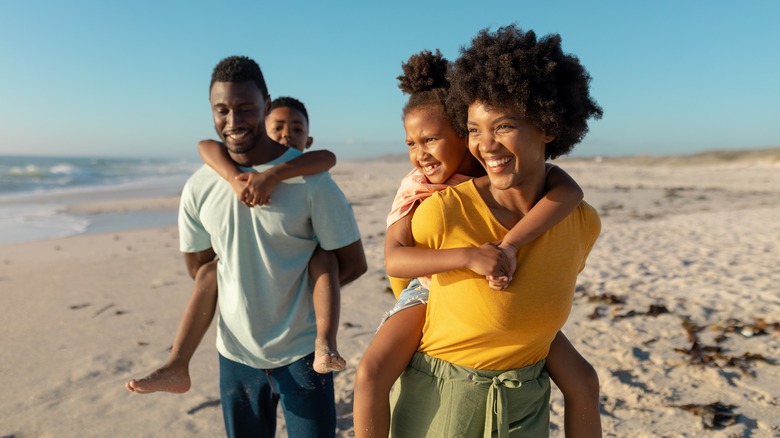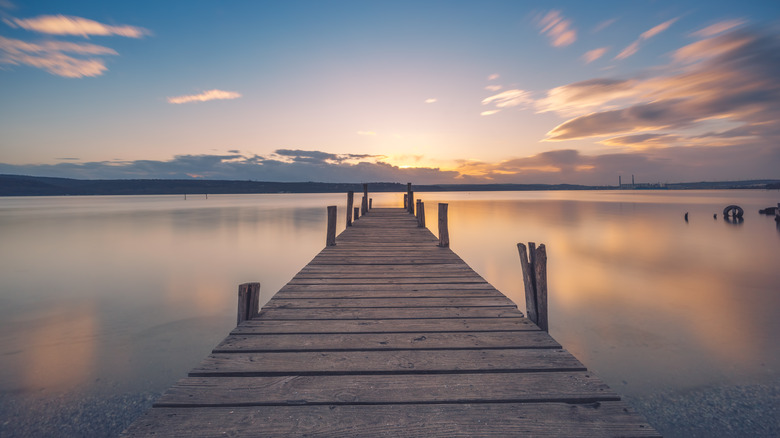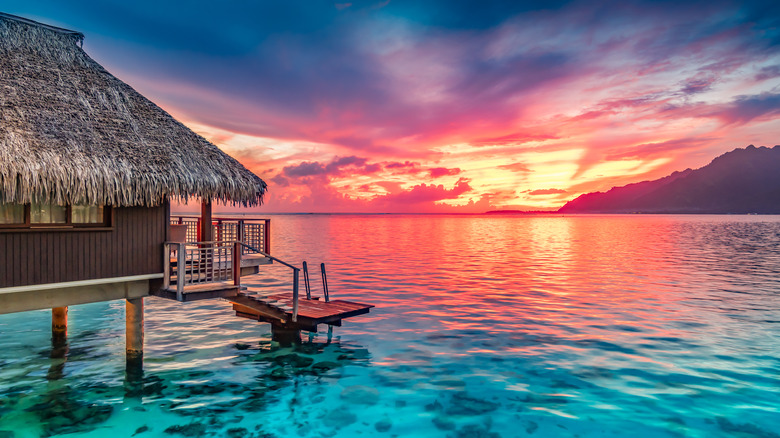The Best French Polynesia Overwater Bungalows To Book For Your Next Trip
Mention the words French Polynesia to family, friends, or colleagues, and images of an idyllic tropical paradise are sure to percolate in their heads. Cue pictures of a fantasy land with leaning palm trees, sugary sand beaches, skies with languid, puffy clouds, crystal-clear, bathtub-warm seas, and sunsets that melt into the sea. This territory in the South Pacific, under French administration, comprises five archipelagoes sprinkled across the ocean like precious baubles (via Britannica). Among the popular destinations here are Tahiti and Bora Bora.
It's also where visitors are spoiled for choice when it comes to the ultimate dream accommodation — the overwater bungalow. This category of room, where lodging is suspended on stilts over the sea, offering views of sea life below, was in fact invented in French Polynesia. Its genesis dates to 1967, the brainchild of three Californians who constructed the bungalow in the shallows off the coast of Raiatea, according to Tahiti Tourisme. Today, the territory has a rich vein of overwater bungalows, with resorts throughout the region offering this slice of holiday paradise as de rigueur. To help visitors make the most appropriate overwater bungalow choice for their trip, read on.
Best for a sense of place
Pandanus, also known as screwpine, is a common tree in this part of the world, and beyond adding a bit of green je ne sais quoi to the scenery, it plays an important part in the culture and architecture throughout the islands (via Tahiti Tourisme). The leaves of the tree, long and firm with distinct ridges, are used for weaving baskets, and for thatch in the roofing of bungalows across the islands. The latter application is evident at Le Bora Bora, part of Pearl Resorts of Tahiti, a Polynesian hotel company.
Here, the local architectural vernacular is seen not just in the large open areas of rooms but also through the adoption of materials commonplace in this region of the Pacific. This is where guests will encounter bamboo, fiber from coconut, the bark called tapa, and the iridescent, multicolored, hypnotic beauty of mother-of-pearl, key components of the resort's sustainable development doctrine. Travelers will notice dried pandanus leaves topping the overwater bungalows, some of which come with views of Mount Otemanu, the highest peak on Bora Bora (via Britannica).
Best for spa lovers
Most luxury resorts here have accomplished spas, but few can compete with the one at the Intercontinental Bora Bora Resort & Thalasso Spa, which focuses on hydrotherapy and uses water pulled from the depths of the Pacific. According to the paper Scientific Evidence-Based Effects of Hydrotherapy on Various Systems of the Body, published in the North American Journal of Medical Sciences, hydrotherapy, alternatively known as water therapy and balneotherapy, has a long tradition. The treatment, using water at varying temperatures to address ailments, appeared in ancient Egypt, China, and India. The study showed that cold water can act like anesthesia, warm water can reduce heart rate and blood pressure, and winter swimming can even help asthma.
At the InterContinental, the Deep Ocean Spa spreads across more than 43,000 square feet, uses Algotherm products, and offers a deep sea hydromassage bath, where jets circulate water from the Pacific, rejuvenating aching muscles. The treasures of the ocean are also on view at the 88 overwater villas and suites, whose glass-bottomed coffee tables look onto the rich marine life below.
Best for beach bums that have seen it all
For the infrequent beachgoer, sand might seem like sand, right? Not at a small motu — or mini island — on Le Tikehau, which is in the Tikehau atoll, part of the Tuamotu archipelago northeast of Tahiti. Here, many of the beaches have pink sand and since the residents here number only about 400, according to Tahiti Tourisme, there's a good chance you'll be able to enjoy this rose-tinted wonder in relative solitude.
Pink sand isn't an optical trick caused by refracting light or the way the sun hits tan-colored grains at a specific angle. The sand is pink because of its composition, with a marine organism called foraminifera breaking down to create the uniquely hued deposits on the shore, similar to that found across parts of Bermuda (via National Ocean Service). On Tikehau, visitors can enjoy this spectacle from Le Tikehau resort, which in addition to overwater bungalows with lustrous wood floors, has a pool beach villa with its own private pool that is set on its own stretch of pink sand paradise.
Best for marine life
One of the greatest joys in visiting French Polynesia is the ease with which to encounter myriad marine life, from the otherworldly-hued Napolean wrasse to the fluid, alien-like octopus that curls and glides around the coral. Perhaps the most thrilling encounters are with rays and sharks, among them tiger sharks, Galapagos sharks, and the pink whipray (via Shark Search Indopacific). For fans of the underwater environment, rays and sharks are just some of the aquatic wonders that visitors to the Four Seasons Resort Bora Bora might encounter in the property's lagoon. During a safari to spot these grand sea creatures, guests will hear stories about the "fenua" (land), while taking in the sweet island sounds of the ukulele.
Other water activities include a submarine scooter, a snorkeling jet, and snuka (like diving but without the need for cumbersome equipment). For travelers that really want to learn more about the aquatic realm here, time with the onsite marine biologist is an enlightening experience, with private snorkeling tours, the chance to learn about coral grafting, and special programs for kids. The resort also has 108 overwater rooms — 27 of them with their own private plunge pool suspended above the lagoon— that couldn't be closer to the riches of the ocean.
Best for foodies
Among the four restaurants and two bars at the St. Regis Bora Bora Resort is Lagoon Restaurant, with a menu designed by star Alsatian chef Jean-Georges Vongerichten and views that take in the sublime scenes of the water from above (the eatery is situated above the lagoon and has glass panels as part of its floor). Born in a part of France close to the border with Germany, Vongerichten trained in his home country and the kitchens of Asia, experiences that inform his cuisine that melds the flavors and techniques of East and West. In addition, the resort also features the Italian Fra Niente, and the open-air restaurant Te Pahu, where Polynesian dishes are offered.
Polynesian food utilizes a number of local products, from breadfruit and coconut to plantains and root vegetables like sweet potato, as well as fresh fish and a rich array of tropical fruits (via Tahiti Tourisme). While dining is available at the resort's restaurants, guests also have the option of 24-hour room service, including delivery to the overwater rooms — the largest being the 3,500 square foot, two-bedroom Overwater Royal Otemanu, with three televisions, a walk-in closet, and served (as are all rooms at this resort) by butlers 24 hours a day.
Best for convenience
Most luxury resorts with overwater bungalows in French Polynesia are located outside the main island of Tahiti, where flights land at the Faa'a International Airport. The airport receives international arrivals from a number of carriers, among them Air France, Air New Zealand, Hawaiian Airlines, and United Airlines. But these carriers don't fly to islands such as Bora Bora, so getting to your resort might require taking a domestic flight aboard Air Tahiti.
If you want to stay at an overwater bungalow, but don't want to take the connecting flight, consider staying at the InterContinental Tahiti Resort & Spa. The property is a little more than a mile from Tahiti's airport, so you could even conceivably walk to the resort after your flight lands. Situated southwest of French Polynesia's capital Papeete, and just south of the airport, the resort spreads along a stretch of beachfront, with views of the island of Moorea, a swim-up bar, and overwater rooms where the outdoor terrace with lounge chairs allows guests to soak in the sublime scenery in supreme comfort.
Best for travelers on a budget
Traveling to this part of the world takes some effort, and expense, and once here, the overwater lodging isn't cheap, which is not surprising since it's a marvel of marine engineering, an icon that embodies the image of fantasy accommodation. Overwater bungalows at the high-end resorts, the only properties that usually feature this category of room, run in the very high three figures, and even four figures, per night, so a one-week stay in the South Pacific can cost as much as a used sedan back home.
One exception is Maitai Polynesia Bora Bora, a more affordable option located close to the island's only public beach. The rack rates — the official published room price — for the resort's overwater bungalows are about $650, but the rooms can be combined with packages and are sometimes sold by online travel agencies like Expedia and Booking.com, where a better rate might be available. The property itself has two categories of overwater bungalows, both with an outdoor terrace, thatch roof, and serene vistas of the turquoise waters gently lapping below, offering the same experience as pricier resorts but with more bang for the buck.
Best for weddings
The population of French Polynesia is about 300,000, and of that number, more than four-fifths are Christian, either Protestant or Roman Catholic (via The World Factbook). Traditional wedding ceremonies are well-established here and can be performed for visiting couples in civil situations or at destination resorts. Guests should be aware that the proceedings here are typically held in French, the main language of the islands, and follow a specific set of conditions, outlined by Tahiti Tourisme. The upside of holding a wedding here is of course the setting — near water, maybe on a beach, the ceremony kissed by the sun in sultry, warm conditions — as well as the chance to hold a traditional Polynesian wedding service.
A white-sand beach and hilltop chapel are among the venues where couples can tie the knot at the Conrad Bora Bora Nui. Couples can add local touches to their special occasion too, with flower leis and crowns, a wedding certificate that is written on a piece of native bark, and music from the islands adding a bit of Polynesian flair to the milestone. And after the festivities are over, the couple can retire to the comfort of their overwater bungalow, where direct access to the lagoon lets them effortlessly snorkel, or listen to the gentle lilt of the water as newlyweds.
Best for honeymooners
Couples that tie the knot at a French Polynesia resort can simply stay at their resort for the honeymoon. But for anyone looking for a change of scene, or duos seeking a sublime spot just for the honeymoon, take a look at Vahine Island Resort and Spa. An intimate private island with just 15 rooms, the property is perfect for newlyweds thanks to its policy on children — since all kids on the island as guests have to be 10 or over, visitors will encounter no screaming babies or families with impatient toddlers in tow.
A mere wisp of an island — it's only 23 acres in size (or about 17 football fields, according to this calculation by the Langley Rams) — off the northeast coast of Taha'a, Vahine can be traversed in just a few minutes, but its Lilliputian proportions make it an intimate refuge for two. Of the 15 rooms, only nine are bungalows, some on the beach, others overwater, the latter offering glass panels on the floor through which to feed fish below, a honeymoon memory that will last a lifetime.
Best for dramatic scenery
Like many islands that make up French Polynesia, Moorea exists today as the remnant of an extinct volcano, with vertiginous, verdant scenery of peaks and jungles, topping out at the 3,960 feet Mount Tohivea (via Britannica). The forested spikes, contrasting gloriously with the gorgeous clear water in the lagoon, are very much on show as the backdrop at the Sofitel Kia Ora Moorea Beach Resort.
This part of the world is a marvel of nature, and guests of the resort can wander and wonder in awe at the views presented at every turn. The island itself is a short ride from Tahiti by boat — 30 minutes by Terevau fast ferry, a good option for guests that prefer not to take a domestic connecting flight to an island further out. The French Post-Impressionist painter Paul Gauguin, who moved to Tahiti in 1891 (via Art UK), is the inspiration behind the decor in the Superior Overwater Bungalow, the starter category of this type of room at the resort, adding an artistic aura to the scenic splendor.
Best for families
Another resort located in Moorea, Manava Beach Resort & Spa has overwater bungalows with glass floors, simple interiors with high peaked ceilings and wooden floors, touches of bright color in the artwork, and a soothing ambiance. What makes the resort really stand apart for adults on vacation with kids is the Family Garden Duplex category of rooms. Split between the main level and the mezzanine, the 635-square-foot accommodation features one king-size bed, two twin beds, and a balcony that comes with a view of the garden, allowing parents and children separate yet connected spaces.
Other activities at the resort that will appeal to families are horseback riding at a nearby valley and plantation, hikes including one to a waterfall, a jeep safari to explore the island, a workshop on coral grafting that can help to repopulate the reefs around Moorea, and the chance to snorkel in the water right from the shore.
Best for a complete escape
Set on the private Motu Tautau just off the island of Taha'a, and with a view of Bora Bora a few miles to the northwest, Le Taha'a allows guests to feel like their own Robinson Crusoe, luxe-style. For a real hideaway experience, some travelers arrive at the resort by helicopter from Bora Bora, a 14-minute flight that takes in turquoise lagoons ceding to fringing reefs. The property proudly showcases Polynesian design, with pandanus thatch roofs, and tapa cloths from the Marquesas (one of the five archipelagoes of French Polynesia), among other touches visible in all rooms. These include overwater suites, sitting above the lagoon with interiors in soothing browns and beiges; the Sunset Overwater Suites add stunning dusk views to the mix.
Taha'a is also known as the vanilla island, and an excursion with Vanilla Tours will illuminate guests on the island's botany. The tour stops at a vanilla plantation for a deep dive into the labor-intensive process required to rear the reedy spice. The concierge at Le Taha'a can also organize a visit to one of Taha'a's pearl farms, a fine destination to buy a gift for someone special.
Best for a change of scenery
Rangiroa is a huge atoll in the Tuamotu archipelago — its 240 isles form a ring around stunning clear waters, a utopia of land and sea. Within that atoll, the Hotel Kia Ora Resort & Spa is a comfortable refuge between Avatoru and Tiputa, it's a skinny island that isn't a typical stop for visitors to French Polynesia, as most tend to flock to the marquee stops of Tahiti and Bora Bora. This means that a visit here affords intrepid explorers some bragging rights. The property has just 10 overwater bungalows, but they check all the boxes for this type of accommodation — thatch roof, roomy interior, outdoor terrace for enjoying the view, glass floor panel to admire the fish below in the lagoon, and direct access into the water so you can just slide into the silky shallows.
Though Rangiroa might not be as internationally recognized as Tahiti or Bora Bora, it does excel in one respect — diving. According to Scuba Diver Life, this atoll is the best place in French Polynesia for scuba, and divers might expect to encounter hammerhead sharks, leopard rays, and bottlenose dolphins. Now that's something you don't see every day.
